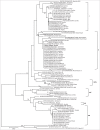Genetic characterisation of African swine fever virus from 2017 outbreaks in Zambia: Identification of p72 genotype II variants in domestic pigs
- PMID: 30035596
- PMCID: PMC6238689
- DOI: 10.4102/ojvr.v85i1.1562
Genetic characterisation of African swine fever virus from 2017 outbreaks in Zambia: Identification of p72 genotype II variants in domestic pigs
Abstract
African swine fever (ASF) is a contagious haemorrhagic disease associated with causing heavy economic losses to the swine industry in many African countries. In 2017, Zambia experienced ASF outbreaks in Mbala District (Northern province) and for the first time in Isoka and Chinsali districts (Muchinga province). Meanwhile, another outbreak was observed in Chipata District (Eastern province). Genetic analysis of part of the B646L gene, E183L gene, CP204L gene and the central variable region of the B602L gene of ASF virus (ASFV) associated with the outbreaks in Mbala and Chipata districts was conducted. The results revealed that the ASFV detected in Mbala District was highly similar to that of the Georgia 2007/1 isolate across all the genome regions analysed. In contrast, while showing close relationship with the Georgia 2007/1 virus in the B646L gene, the ASFV detected in Chipata District showed remarkable genetic variation in the rest of the genes analysed. These results suggest that the Georgia 2007/1-like virus could be more diverse than what was previously thought, underscoring the need of continued surveillance and monitoring of ASFVs within the south-eastern African region to better understand their epidemiology and the relationships between outbreaks and their possible origin.
Keywords: African swine fever; Zambia; domestic pigs; genotyping; molecular epidemiology.
Conflict of interest statement
The authors declare that they have no financial or personal relationships which may have inappropriately influenced them in writing this article.
Figures


Similar articles
-
Co-circulation of multiple genotypes of African swine fever viruses among domestic pigs in Zambia (2013-2015).Transbound Emerg Dis. 2018 Feb;65(1):114-122. doi: 10.1111/tbed.12635. Epub 2017 Mar 15. Transbound Emerg Dis. 2018. PMID: 28299893
-
Diagnosis and genotyping of African swine fever viruses from 2015 outbreaks in Zambia.Onderstepoort J Vet Res. 2016 Apr 29;83(1):a1095. doi: 10.4102/ojvr.v83i1.1095. Onderstepoort J Vet Res. 2016. PMID: 27247062 Free PMC article.
-
Genetic profile of African swine fever virus responsible for the 2019 outbreak in northern Malawi.BMC Vet Res. 2020 Aug 28;16(1):316. doi: 10.1186/s12917-020-02536-8. BMC Vet Res. 2020. PMID: 32859205 Free PMC article.
-
The Epidemiology of African Swine Fever in "Nonendemic" Regions of Zambia (1989-2015): Implications for Disease Prevention and Control.Viruses. 2017 Aug 23;9(9):236. doi: 10.3390/v9090236. Viruses. 2017. PMID: 28832525 Free PMC article. Review.
-
[African swine fever in Russian Federation].Vopr Virusol. 2012 Sep-Oct;57(5):4-10. Vopr Virusol. 2012. PMID: 23248852 Review. Russian.
Cited by
-
Genetic Characterisation of African Swine Fever Virus in Outbreaks in Ha Nam Province, Red River Delta Region of Vietnam, and Activity of Antimicrobial Products Against Virus Infection in Contaminated Feed.J Vet Res. 2020 Jun 16;64(2):207-213. doi: 10.2478/jvetres-2020-0041. eCollection 2020 Jun. J Vet Res. 2020. PMID: 32587906 Free PMC article.
-
Structural Insight into African Swine Fever Virus dUTPase Reveals a Novel Folding Pattern in the dUTPase Family.J Virol. 2020 Jan 31;94(4):e01698-19. doi: 10.1128/JVI.01698-19. Print 2020 Jan 31. J Virol. 2020. PMID: 31748385 Free PMC article.
-
Molecular Characterization of ASFV and Differential Diagnosis of Erysipelothrix in ASFV-Infected Pigs in Pig Production Regions in Cameroon.Vet Sci. 2022 Aug 18;9(8):440. doi: 10.3390/vetsci9080440. Vet Sci. 2022. PMID: 36006355 Free PMC article.
-
African Swine Fever Virus (ASFV): Biology, Genomics and Genotypes Circulating in Sub-Saharan Africa.Viruses. 2021 Nov 15;13(11):2285. doi: 10.3390/v13112285. Viruses. 2021. PMID: 34835091 Free PMC article. Review.
-
Systematic Review of Important Viral Diseases in Africa in Light of the 'One Health' Concept.Pathogens. 2020 Apr 20;9(4):301. doi: 10.3390/pathogens9040301. Pathogens. 2020. PMID: 32325980 Free PMC article.
References
-
- Achenbach J.E., Gallardo C., Nieto-Pelegrín E., Rivera-Arroyo B., Degefa-Negi T., Arias M. et al. , 2017, ‘Identification of a new genotype of African swine fever virus in domestic pigs from Ethiopia’, Transboundary and Emerging Diseases 64, 1393–1404. https://doi.org/10.1111/tbed.12511 - DOI - PubMed
-
- Agüero M., Fernández J., Romero L., Sánchez Mascaraque C., Arias M. & Sánchez-Vizcaíno J.M., 2003, ‘Highly sensitive PCR assay for routine diagnosis of African swine fever virus in clinical samples’, Journal of Clinical Microbiology 41, 4431–4434. https://doi.org/10.1128/JCM.41.9.4431-4434.2003 - DOI - PMC - PubMed
-
- Bastos A.D., Penrith M.L., Crucière C., Edrich J.L., Hutchings G., Roger F. et al. , 2003, ‘Genotyping field strains of African swine fever virus by partial p72 gene characterisation’, Archives of Virology 148, 693–706. https://doi.org/10.1007/s00705-002-0946-8 - DOI - PubMed
-
- Bastos A.D.S., Penrith M.L., Macome F., Pinto F. & Thomson G.R., 2004, ‘Co-circulation of two genetically distinct viruses in an outbreak of African swine fever in Mozambique: No evidence for individual co-infection’, Veterinary Microbiology 103, 169–182. https://doi.org/10.1016/j.vetmic.2004.09.003 - DOI - PubMed
-
- Boshoff C.I., Bastos A.D., Gerber L.J. & Vosloo W., 2007, ‘Genetic characterisation of African swine fever viruses from outbreaks in southern Africa (1973–1999)’, Veterinary Microbiology 121, 45–55. https://doi.org/10.1016/j.vetmic.2006.11.007 - DOI - PubMed
MeSH terms
LinkOut - more resources
Full Text Sources
Other Literature Sources
